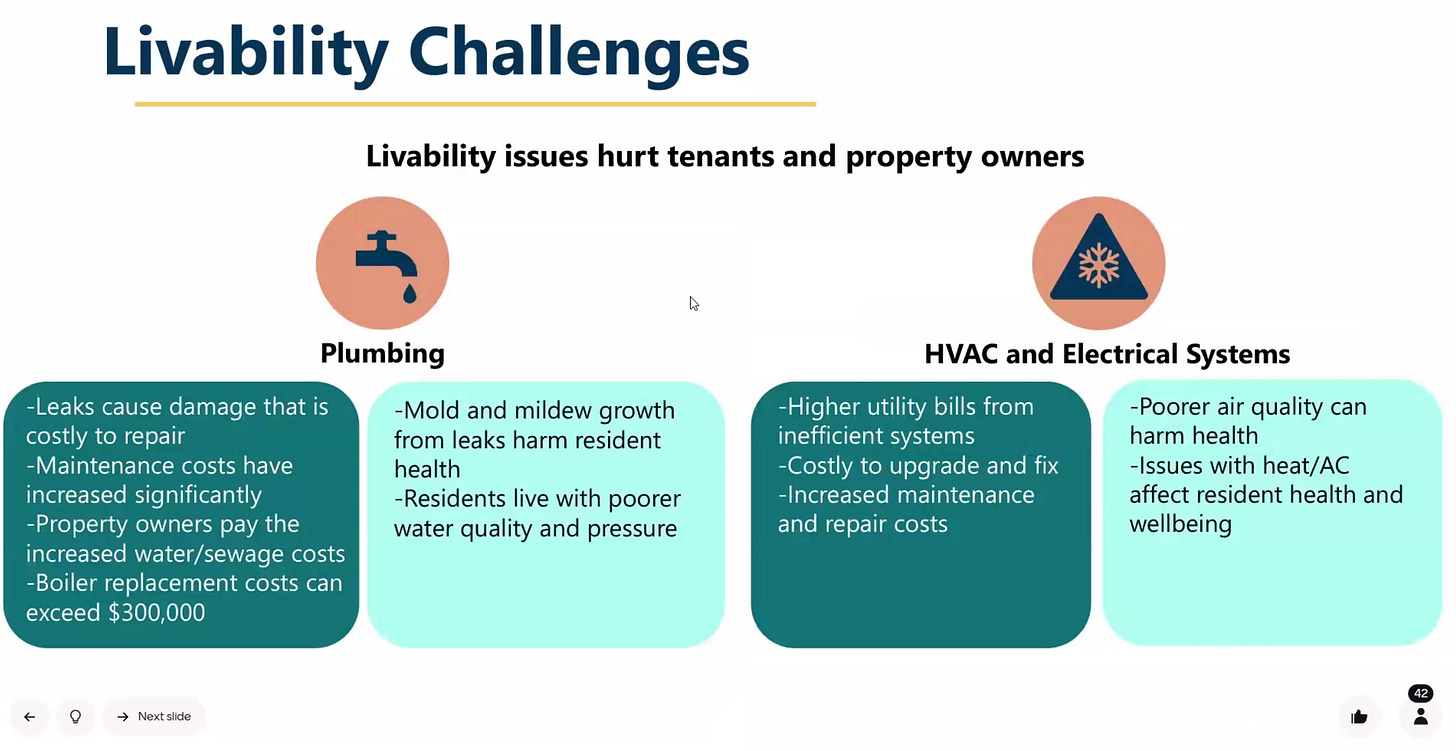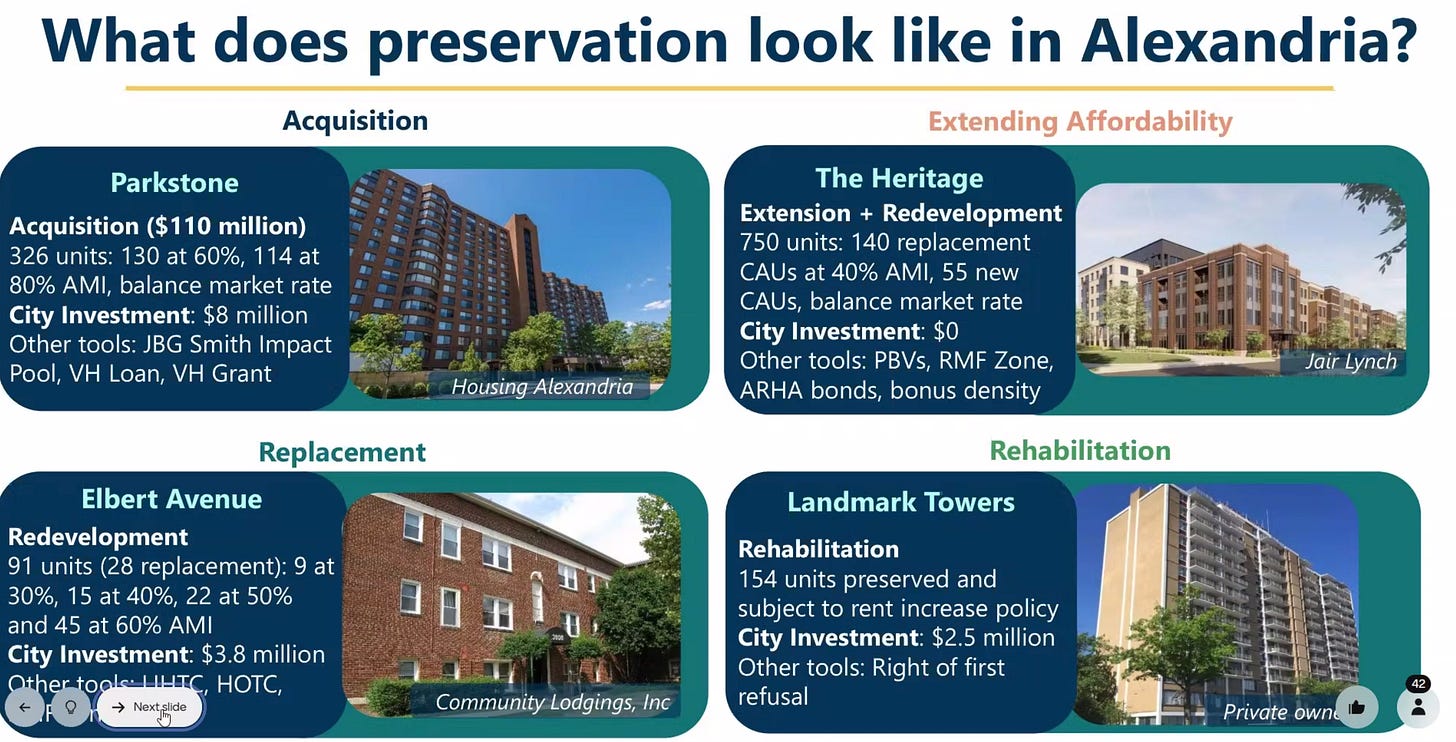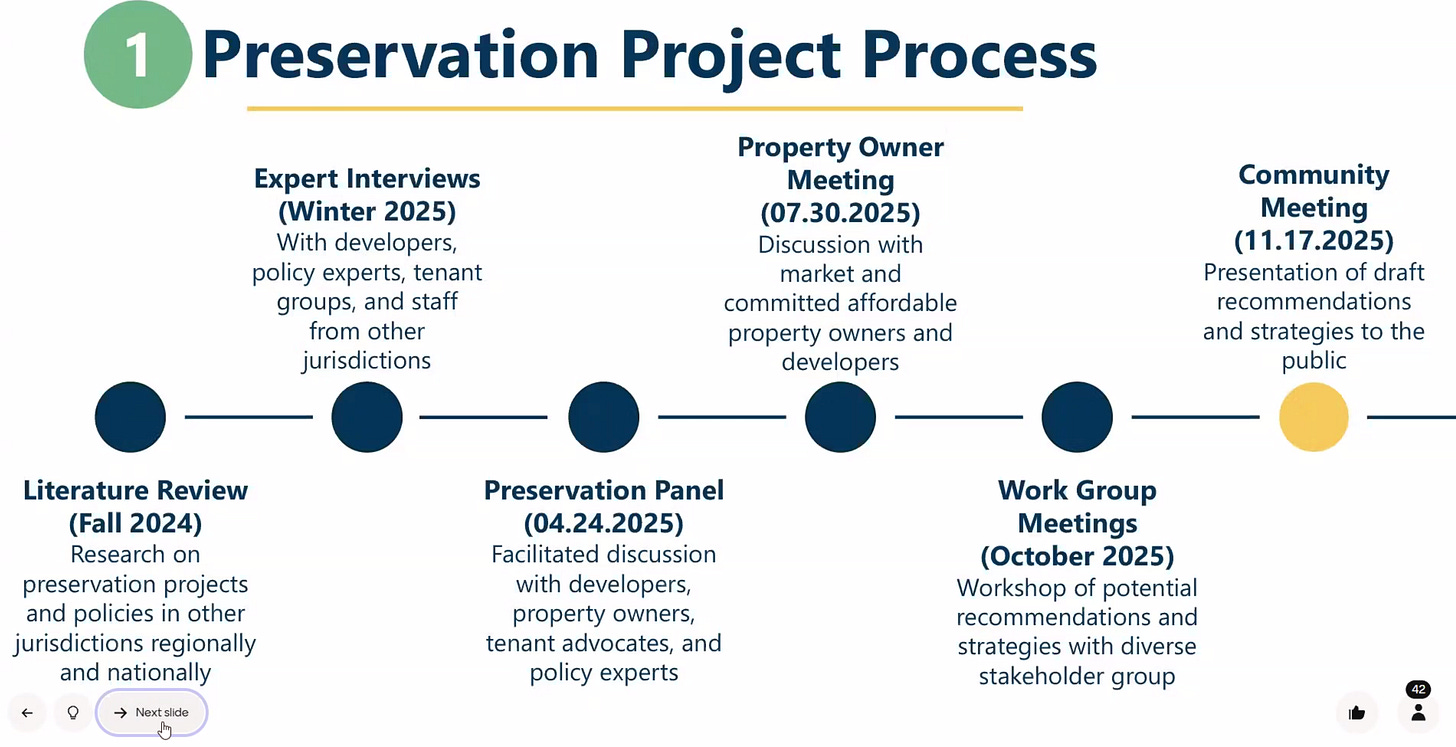Alexandria proposes 40 strategies to preserve affordable housing, protect tenants
Many key tenant protections require state legislative approval; funding sources remain uncertain
Alexandria has lost nearly two-thirds of its naturally affordable housing since 2000—some 11,000 apartments that once housed working families now priced beyond their reach. On Monday night, city officials unveiled an ambitious, 40-strategy plan to stop the bleeding during a Housing 2040 Community Meeting.
Housing officials outlined the comprehensive package during a virtual community meeting, presenting draft recommendations for both landlord-tenant protections and affordable housing preservation over the next 15 years. The proposals aim to help residents remain in their communities safely and affordably while maintaining the city’s existing affordable housing stock.
But many of the most significant measures require Virginia’s General Assembly to grant Alexandria new authority—an uphill battle in a state that has historically favored property rights over tenant protections. And officials acknowledged that implementing the plan will require substantial funding from sources that remain uncertain.

The scale of the crisis
The stakes are high: Alexandria’s market-affordable housing stock has plummeted from 18,000 units in 2000 to just 6,900 today—a 62% decline. Another 900 subsidized affordable units face expiring commitments by 2040 if their affordability isn’t extended.
“By 2040 we have identified about 900 committed affordable units that are at risk of expiration,” said Christopher Do, a housing analyst focused on preservation.
The city has approximately 42,000 multifamily rental units total, with about 25% classified as either market affordable or committed affordable housing. Market affordable units are those naturally affordable to households earning up to 60% of area median income—roughly $68,880 for a single person—without any government subsidies or rent restrictions.
“How should Alexandria protect residents from displacement?” asked Dominic Ruiz, a housing analyst in the Landlord-Tenant Division. “Which strategies should we prioritize?”
Local strategies vs. state approval
The city divided its anti-displacement strategies into two categories: those that can be implemented immediately and those requiring state legislative approval.
Local strategies include expanding emergency rental assistance, providing legal support for vulnerable tenants, implementing relocation assistance programs, and expanding city rental subsidies. The city also proposes local preference policies that would prioritize current Alexandria residents for new affordable housing in their neighborhoods, though officials acknowledged potential fair housing legal challenges.
“We do know that in Alexandria, 95% of eviction cases are for non-payment of rent,” Ruiz said, highlighting the importance of emergency rental assistance programs that address issues before they reach the courts.
But many of the most significant tenant protections—including just cause eviction requirements, rent increase caps, mandatory relocation assistance funded by landlords, and a rental registry tracking all landlords and rents—would require Virginia’s General Assembly to grant Alexandria new authority.
“Unlike some other states, here in Virginia, a locality can only take the actions that are expressly authorized in writing at the state level,” said Mary Horner, division chief of the Landlord-Tenant Division, explaining Virginia’s Dillon Rule limitations. “Through legislation, if there’s some type of enabling legislation that will allow us to act, without that legislative authority, we cannot act.”

Eight proposed tenant protection strategies require Virginia General Assembly approval, including just cause eviction, anti-rent gouging measures, and landlord-funded relocation assistance. (City of Alexandria)The city is seeking state approval for eight major tenant protection measures, including:
Just cause eviction (landlords would need legitimate reasons to evict)
Anti-rent gouging (caps on annual rent increases and excessive fees)
Required rent payment plans before eviction filing
Limitations on junk fees (mandatory internet, pet, amenity charges)
Rental registry (database tracking all landlords, rents, and eviction patterns)
Right to stay/return (tenants displaced during renovations could return at comparable rents)
Landlord-funded relocation assistance (property owners would pay moving costs for displaced tenants)
Local authority to enforce habitability standards (city could sue landlords for unsafe conditions)
Community polling during the meeting showed strong support for these measures, with anti-rent gouging and fee limitations receiving substantial support among the 40-45 participants.
The city already provides several tenant protections, including emergency rental assistance administered by the Department of Community and Human Services, landlord-tenant mediation services, and courthouse navigation support through Legal Services of Northern Virginia.
A deteriorating housing stock
The preservation challenge is compounded by the age of Alexandria’s rental housing. The median multifamily rental building dates to 1966, and some 20,750 rental units—about half the city’s stock—were built before 1984.

“Boiler replacement costs end up costing about $300,000,” Do said, illustrating the financial squeeze facing property owners. “And that might have gone up since we got that estimate. So things are very, very expensive. And then on the opposite side, we know that mold and mildew develop from these leaks for plumbing issues. And then residents have to live with the effects on their health.”
Operating costs for nonprofit affordable housing providers have jumped from $8,300 per unit in 2020 to $10,300 in 2024—a 24% increase. Insurance costs have risen 25-35% annually in some years, while staffing and utility costs continue climbing.
Without intervention, many aging affordable buildings face a grim choice: massive capital investments owners can’t afford, deteriorating conditions that drive out tenants, or sale to market-rate developers.
Four-pronged preservation approach
Do presented strategies for maintaining the city’s affordable housing stock through four major approaches: extending affordability commitments, supporting acquisition, rehabilitating existing housing, and ensuring one-for-one replacement during redevelopment.
“We have defined preservation as the act of investing in existing housing to protect its long-term affordability, livability and financial viability,” Do said.
Since 2013, the city has acquired or helped preserve 660 units, extended affordability for 152 units, and rehabilitated 888 affordable units. Major projects include the $110 million acquisition of the 326-unit Parkstone Alexandria property (with $8 million in city investment) and the $2.5 million rehabilitation of the 154-unit Landmark Towers.

Specific strategies in the draft recommendations include:
Extending affordability commitments:
Providing financial and technical assistance to property owners to extend affordability
Maintaining an annual inventory of properties with expiring commitments
Pursuing state legislative authority for right of first refusal on committed affordable properties
Building relationships with property owners
Exploring options to extend affordability of rental set-aside units
Supporting acquisition:
Developing strategic preservation priorities to guide decisions
Partnering with nonprofit developers and the Alexandria Redevelopment and Housing Authority
Pursuing joint ventures with anchor institutions like hospitals, churches, and universities
Establishing a “strike fund”—a pool of rapid-response capital to acquire at-risk properties before market-rate investors can
Including right of first refusal in city-funded deals
Rehabilitating existing housing:
Funding capital needs assessments for priority properties
Creating a rehabilitation project pipeline offering city assistance in exchange for affordability commitments
Exploring property tax relief as a financial incentive
Supporting energy efficiency improvements with state and federal funding
Evaluating a program focused on small properties (2-49 units)
One-for-one replacement:
Supporting one-for-one replacement of affordable units during redevelopment
Exploring developer fee relief and tax incentives
Using zoning tools like bonus density and height to incentivize replacement
Requiring developers to document displacement impact and identify mitigation actions
“We would support projects replacing all 30 units in the new building that’s being redeveloped to the greatest extent possible to minimize displacement of the existing residents and communities,” Do explained, using a hypothetical example.
The funding gap
Officials acknowledged that implementing the plan will require significant resources but provided no cost estimates Monday night.
“I think that given our current budget environment and sort of the financial uncertainty and the ongoing financial uncertainty around the federal government, the coming year is very likely to be a year where we’re continuing to plan and look at how we can marshal resources,” said Helen McIlvaine, housing director.
Past preservation projects illustrate the scale of investment required. The city contributed $8 million to help preserve the 326-unit Parkstone Alexandria property—part of a $110 million total acquisition. The rehabilitation of Landmark Towers required $2.5 million in city funds.
Do noted the city is positioning itself to capture emerging state and federal preservation funding opportunities. “We are also trying to be proactive as a city and as a housing department as new opportunities are being considered and discussed specifically with preservation,” he said. “It is becoming a very hot topic. But it is something that at the state level and even at the federal level, there are discussions for new ways to fund preservation projects.”
The city’s FY26 budget includes $17.3 million for housing initiatives, including annual dedicated revenues from one cent of the real estate tax rate and a 1% meals tax.
Community priorities
During the virtual meeting, live polling revealed resident priorities. For local strategies that don’t require state approval, expanding city rental subsidies received the most support with 8 votes, followed by emergency rental assistance with 6 votes and local preference policies for current residents with 3 votes. Continued courthouse navigation support and relocation assistance each received 1 vote, while implementing emerging eviction intervention tools received no votes.
Collaborative approach
McIlvaine emphasized the extensive stakeholder engagement behind the recommendations. “We’ve been meeting with various stakeholder focus groups and community partners to learn about perspectives of specific communities,” she said.
The city conducted extensive research, including a quantitative housing needs assessment, public surveys reaching 1,200 participants, and stakeholder meetings with property owners, tenant advocates, and policy experts. The process included a preservation panel discussion in April 2025, property owner meetings in July, and work group sessions in October.

One of the Housing 2040 plan’s core principles, McIlvaine noted, commits the city to advancing “social, economic, cultural, racial and generational diversity by supporting housing stability and increasing access to housing options and types at a variety of price points across all neighborhoods.”
Tamara Jovovic, housing program manager, explained the master plan’s significance. “At a more personal level, a housing master plan is important because it helps to impact how affordable housing is created, where it’s preserved, what type of tenant protections we would advocate for,” she said.
Next steps

Officials plan to continue gathering community feedback through December 30, with the next Alexandria Housing Affordability Advisory Committee meeting scheduled for December 4 at 7 p.m. in City Hall. Additional outreach to property owners, tenants, and community groups will continue through fall 2025.
The Housing 2040 community meeting is scheduled for February 28, 2026, where all recommendations will be discussed before moving to public hearings in spring 2026. Implementation is expected to begin in summer or fall 2026—nearly a year away.
Implementation is expected to begin in summer or fall 2026—nearly a year away. The city has lost an average of more than 400 market-affordable units per year since 2000, with 11,100 units converting to market-rate housing over that 25-year period.
The city emphasized that implementing the full plan will require leveraging city funds with participation from multiple partners, including nonprofit developers, the Alexandria Redevelopment and Housing Authority, regional funding sources, and state and federal programs.
Community members can provide feedback through the city’s website at alexandriava.gov/HousingPlan. The comment period for preservation and landlord-tenant recommendations closes December 30.

